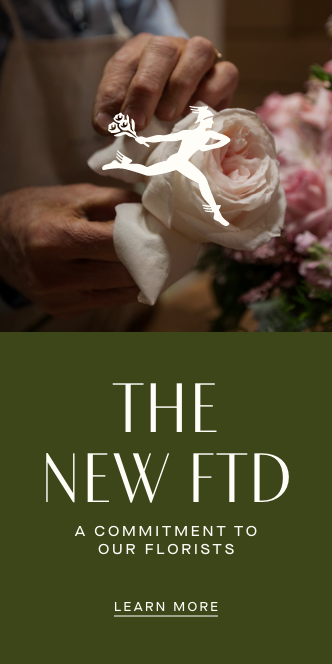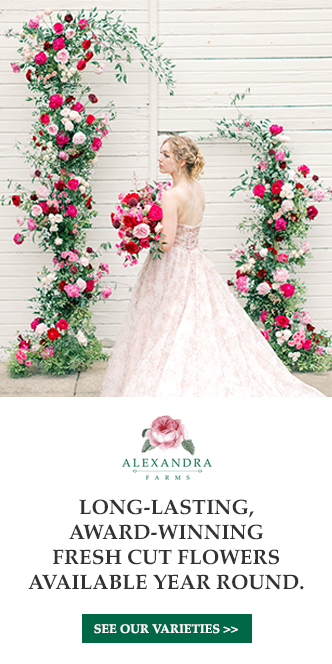Take an inside look at how a leader in breed development delivers innovation to the flower industry.
By Bianca Bina
Every ruffle of a petal, every shade of a beloved hue, each delicate fragrance and all the unique qualities that make every flower distinctively different fuel the passion for floristry. The process of achieving such beauty is often overlooked or taken for granted. But the true design of a stem starts at the very beginning, with seed breeding, a meticulous scientific focus that takes time and patience.
In the flower industry supply chain, it’s the breeders who create the first and most important step of developing new varieties. They deliver the seeds, cuttings, bulbs or rose budwoods to be propagated by growers. The rest of the processes carry the developed variety to market, but the most crucial point is the initial development of seeds.
Dümmen Orange is a leader in breed development with a concentration on strength, health and diversity in a broad range of plant and flower varieties. Their breeds set them apart from other companies with their ability to create varieties that resist disease, and form noticeably unique traits and beneficial growth habits.
“At Dümmen Orange, we’re excited to see more people—especially florists and consumers—showing genuine interest in learning about the journey behind each flower,” says marketing lead Alejandra Fernandez. “The story of how a variety is bred, selected and brought to market is full of science, creativity and passion, and we’re proud to be advocates for sharing that knowledge.”

Breeding begins with an idea. A grower envisions an as-of-yet unavailable style, color or combination of characteristics, and approaches a breeder like Dümmen Orange. Often the breeder’s team attends an event and discusses florists’ desires for a variety that doesn’t exist, and sometimes the breeder team decides they want to pursue their own variety. Regardless of where the idea originates, the creativity and desire of industry professionals generates a spark that ignites scientific discovery.
Emily Leggatt, PhD, is a rose breeder for Dümmen Orange at the company’s home base in the Netherlands. When she and her team receive a request from a grower, they immediately get to work by first considering the biology of the seeds and the process of seed generation. “It takes a year to 16 months to get from seed to growing plants from that point onwards,” she says. “It takes five to seven years after that to achieve a commercial variety and be able to give that customer back their variety.”
Seed generation begins with a simple process of cross-pollination between two flower varieties. The petals are removed from each flower to expose the reproductive parts, and then the pollen from one flower is transferred to the stigma of the other. This exchange allows the genetic material of both plants to combine, eventually producing seeds. This process typically takes place in the spring, with seeds developing by fall, followed by months of growth monitoring, testing and analysis.
At the foundation of the business, Dümmen Orange’s Intrinsa Plant Power was developed in 2015 to support efficient breeding through phenotyping, predictive breeding and greenhouse validation, helping to identify traits linked to disease and virus resistance. This technology is vital for developing seeds with enhanced resistance; it identifies and selects strong genetic traits and carefully upgrades the DNA.
“We’re always on the lookout for new strains of diseases to make sure that we’re on the forefront,” says Leggatt. “And if we’re not ahead, we’re at least on par with the grower so that we have a solution for them.”
Not only does Intrinsa technology provide a solid barrier against disease, but it helps plants grow resistant to various types of stress. This encompassing resistance is a catalyst for sustainability on grower farms, where pest control and other chemical applications are no longer required for hardy plant growth.
“We’re implementing genetic tools that 10 to 20 years ago may not have existed,” Leggatt adds. “So, we’re really at the forefront of implementing new technology.”
In 2020, Dümmen Orange announced the first product tested with its Intrinsa breeding program: Ditto—a series of garden mums bred for white-rust resistance. By 2022, more than 80 percent of all garden mums offered by the company were rust resistant.
“Through our Intrinsa breeding program, we’re developing varieties that are more resistant to the most common crop diseases, allowing growers to reduce their use of chemicals and contribute to a more eco-friendly floral industry,” Fernandez notes. “Our goal is to create flowers that are not only beautiful and high performing, but also responsibly bred for the future.”
The benefits this technology offers growers go beyond cost savings, sustainability and producing hardier, high-performing crops that meet consumer expectations. The rising cost of flower production reflects the value of Intrinsa’s innovation, which enhances product quality—a key concern for consumers.
When the seed has been created, the first phase of selection takes hold. Seeds are planted and analyzed as they grow in Dümmen Orange’s glass-covered greenhouse in the Netherlands, the largest breeding laboratory in the world for ornamental crops. Seeds are also propagated on more than 260 hectares across Africa, South and Central America and Asia, where they’re tested in various climates and conditions prior to production.
The first blooms are measured for stem length, prickle count, petal count and color, and all data is collected for further testing. Any adjustments at this phase will be made and then further analyzed for desired successes before moving onto the next phase. The second phase of testing new breeds includes phase life analysis. Here, Leggatt and her team will evaluate scent and other important client-desired characteristics, if applicable. Further data is collected and analyzed, and as the process continues the number of available stems dwindles to only the strongest and most desirable ones.

In the final phase, varieties have passed the selection process and are named before heading to production. The focus is on consistent stems with high production value and copious amounts of buds. To achieve this, growers will perform grafting, a process that combines the rootstock and a cutting or bud-eye to propagate, which will help enforce protection from root diseases and increase productivity.
As for roses, they’ll continue to be monitored in the company’s glass greenhouse for a year to two years. “At that stage, they start to test in different locations, in different trials,” Leggatt says. “So, they get shipped to Colombia, Ecuador, Kenya, and the trials are then on location. And that’s very important, as well as the feedback.”
While testing in both the Netherlands and in other countries happens simultaneously, the data is compiled and compared, providing a determination for which breed moves forward to the final phases of production. With each new variety, the findings are applied to future varieties to strengthen their biological resistance and physical traits. The ever-evolving genetics of every plant breed drive the development of new technologies designed to predict, analyze and assess performance.
The full breeding and trial process from beginning to end is extensive. It includes numerous rounds of testing and analysis. Depending on the type of crop, developing a new variety can take seven years for roses, six years for carnations, five years for mums and more than 10 years for tulips and calla lilies.
This lengthy process from start to finish is paid, in part, by growers through license fees and royalties, so that they can be cultivated on a commercial scale. These fees are used to support ongoing research and development, which allows breeders to continue perfecting traits that positively impact the flower industry—from production to retail.
“We test thoroughly,” says Leggatt. “So, towards the end of our program, not only do we have a genetic basis of resistance, but we also have a physiological and plant basis. We’re making sure that the final variety that’s put out there is 100-percent guaranteed resistant.”

While growers are generally making the requests and providing funding for breeding new varieties, it’s the florists who provide the feedback for desirable varieties because of their close connection to consumers.
“The focus of having the discussion with florists and being able to have exposure to many designers is to actually get a little bit more impact or input from them and what they really want,” Fernandez says. “So, we can combine the technical requirements of the grower, but we can also start meeting those visual and design requests designers are looking for.”
Adding florists’ perspectives contributes to the overall industry collaboration when discussing the next breeds on deck for seed creation. “When floral designers have the variety in hand, they open the flower to its fullest expression,” Fernandez says, emphasizing the value of their feedback thanks to the intentional and intimate way florists interact with their blooms.
Florists also provide a point of view that objectively analyzes the end products based on what will ultimately work for consumers and not what will drive the most business for growers. It’s the experience and hands-on education that often helps guide the testing process of seed breeding.
In the end, collaboration between breeders and florists is essential, as it allows Dümmen Orange to gather insights from the very people who engage with the final product at the opposite end of the supply chain. Driven by both feedback and a shared passion for flowers, the company takes pride in working closely with growers and florists to continuously enhance and evolve the world of floriculture.
























